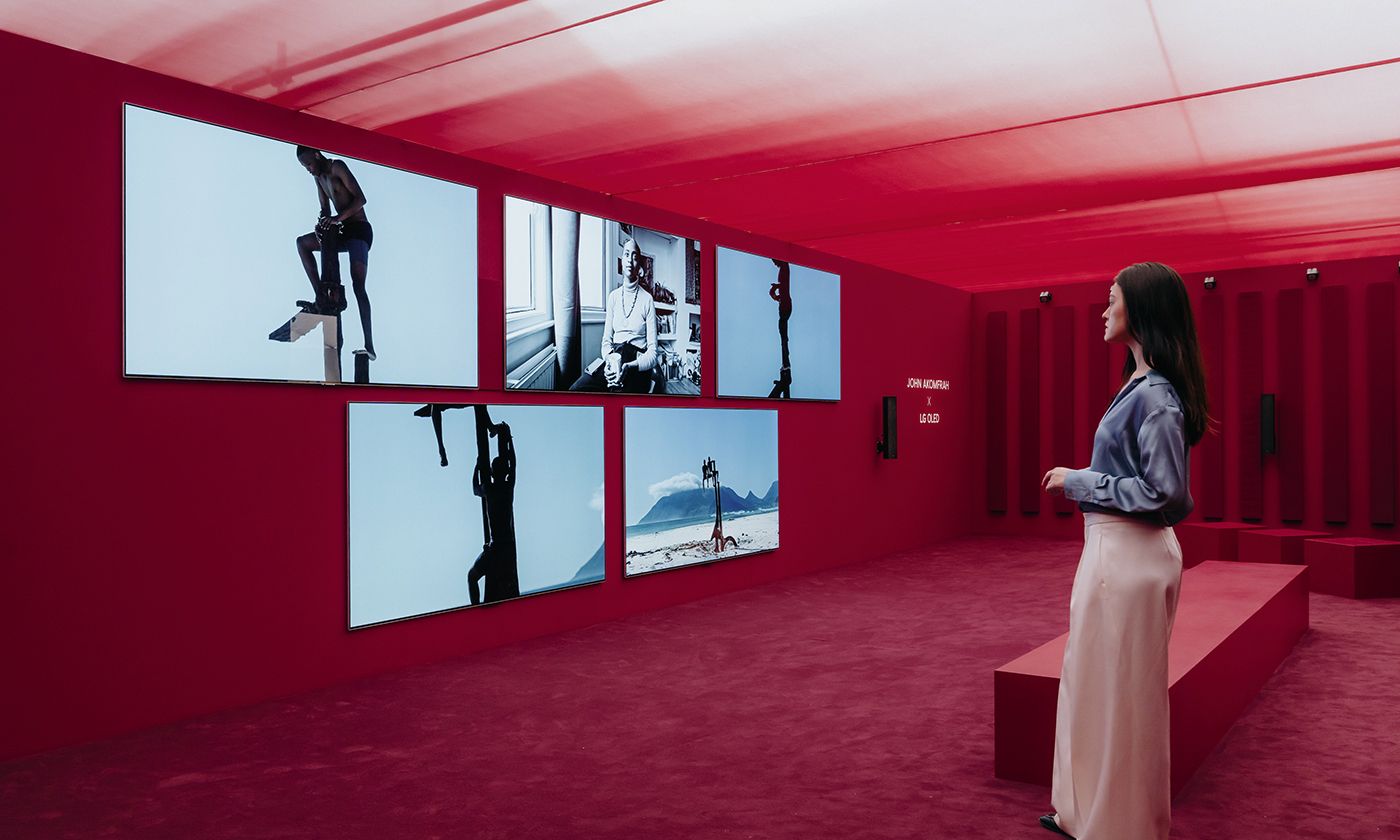John Akomfrah’s Becoming Wind (2023) © the artist; courtesy of LG OLED
John Akomfrah’s Becoming Wind (2023), a five-channel video piece shown on OLED screens and six surrounding speakers, brings music, chants and text to bear in an epic 30-minute meditation on the Garden of Eden, human loss and the effects of climate change. Shielded by the lounge walls from the hurly-burly of the fair outside, the sequence of monochromatic and full-colour clips—of desert, coast, plant life, meditative urban interiors, metro trains and diamond-skinned serpents—grows as beguilingly as the ordering and reordering of the related text statements: “the thing to come… it moves among us”. The piece invites fast-moving fair-goers to absorb themselves in a mind-stilling and thought-provoking experience.
Jacolby Satterwhite’s New World Order (2023-24) Photo: Sebastiano Pellion di Persano; courtesy of the artist and Kadel Willborn
The diaphanous circular animated holograms in Jacolby Satterwhite’s New World Order (2023-24) bring a showstopping allure to the stand of the Düsseldorf gallery Kadel Willborn. Adding to the experience is the pulsing, joy-filled, soundtrack. The work is a development of A Metta Prayer, the artist’s 2023 multimedia commission for the Metropolitan Museum in New York, which was inspired by the Metta prayer, an ancient Buddhist mantra that extols loving kindness.
Katja Novitskova, Pattern of Activation (Gardens of the Galaxy) (2023), left, at Temnikova & Kasela. The two works to the right are by the Finnish artist Jenna Sutela Julian Blum
The Amsterdam-based Estonian artist Katja Novitskova works with found imagery of humanity’s efforts to capture nature through technology—screengrabs from wildlife cams, astronomical phenomena from citizen science platforms—to assemble her fast-paced slideshow of more than 1,500 AI-indexed screenshots Pattern of Activation (Gardens of the Galaxy) (2023). Providing a clinching contrast to the video is Novitskova’s clay epoxy piece Earthware (8/6/2018, When The Samples Are Biased… ) (2023) featuring an antelope caught by an automatic wildlife camera, witnessing a distant wildfire, the image’s accidental beauty overlain with a poem from an academic paper on machine learning: “When the samples are biased / towards more probable sequences / they get easier to read / but less diverse / until the all look / exactly the same…”
Jaime Welsh at Madragoa Photo: The Art Newspaper; © the artist; courtesy of Galeria Madragoa
The young Portuguese artist Jaime Welsh’s painterly reworkings, using imaging software, of his own large-format photographs—stylised, consciously unnerving, sparsely inhabited, interiors—draw the eye to the stand of the Lisbon gallery Madragoa. His installation focuses on images taken in the old Banco Nacional Ultramarino in the Portuguese capital, built in the 1950s at the height of the country’s Estado Novo Fascist regime. The former banking headquarters was recently restored as the home of Lisbon’s new Museu Design (Mude), and Welsh’s work confronts whether such a building, however remodelled, can ever be rid of the associations with the deliberately imposing aesthetic of Portuguese authoritarian architecture.
Lawrence Lek, Guanyin: Confessions of a Former Carebot (2024) Photo: Linda Nylind
Lawrence Lek, the winner of this year’s Frieze Artist Award commission, is showing an absorbing sculpture and video game installation, where visitors can either play or watch the game being demonstrated. The game Guanyin: Confessions of a Former Carebot (2024) features Lek’s music and poetically measured text narrative. The titular AI robot assumes many of the challenges and frustrations of a human’s working life as it cares for self-driving cars. The London-based Lek has been creating for the gaming environment for more than ten years. Speaking about how fair attendees can engage with Guanyin, he says that “the audience for watching people play video games is as large as that of people who want to play the games. So it becomes as much a performance piece, or a public art piece.”

